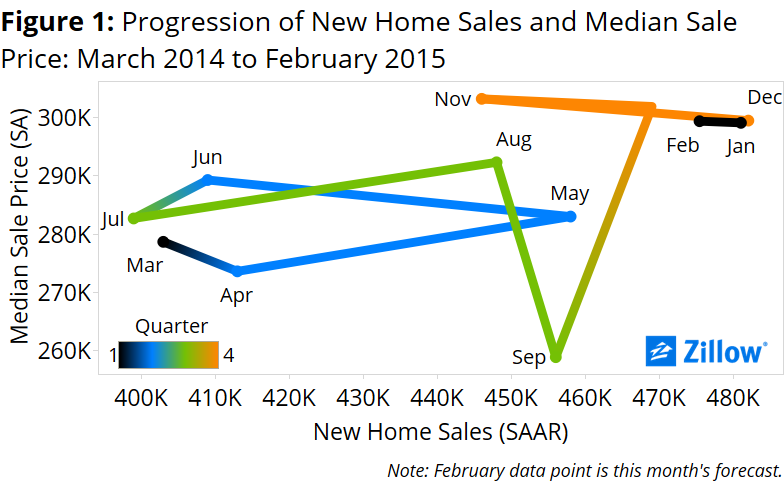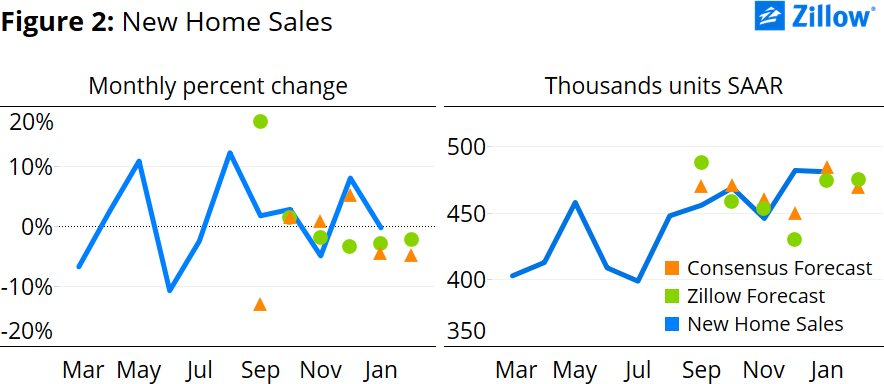- Zillow expects February new home sales to fall 1.2 percent, to 475,000 units (SAAR).
- According to our models, new home sales appear to be more negatively affected by rising interest rates than existing home sales. When the Federal Reserve Board eventually raises rates, this could mean slower sales for new homes compared to existing homes.
Zillow expects Tuesday’s February new home sales data from the U.S. Census Bureau to show a decrease of about 1.2 percent, to a seasonally adjusted annual rate (SAAR) of 475,000 units, down from 481,000 units (SAAR) in January.
Background
Looking back over the past year, January appears to be part of the typical monthly variation, while the trend in new home sales has been toward modestly higher volumes and higher prices (figure 1) [i]. Sales grew 5.3 percent year-over-year in January, but prices grew at a much faster rate of 9.7 percent.

On the demand side, a low homeowner vacancy rate, low inventory and low (and declining) foreclosure activity should all point to strong demand for new homes. But while the supply of new homes has increased modestly, it has remained stubbornly low throughout much of the recovery. In turn, this low supply has been driving substantial increases in prices. There are, however, some signals that construction activity is picking up: The annualized pace of growth of new home starts is higher than it was during the mid-2000s.
This potential market shift may affect new home sales from a different angle than existing sales. Our models suggest a larger negative effect on new home sales than existing home sales when interest rates rise. This could be attributable to recent trends in home construction focusing on higher-end homes that are more expensive to finance. While higher rates may not affect the buying decision of the less-financially constrained, those who are more constrained but considering a newly constructed home could find it financially unfeasible and instead opt not to buy or look to buy a less expensive existing home. Rising wages and employment could outweigh the effect of rising interest rates on home-buying decisions.
February Forecast
Our new home sales forecast uses a best-fit combination of two models, a structural model and a historical model. The models both point in the same direction this month, with the structural model suggesting a slightly smaller decrease than that suggested by the historical model.
The structural model suggests very little change in new home sales, down just 0.5 percent month-over-month to 479,000 units (SAAR). A little boost from unchanged mortgage interest rates, combined with movements in underlying fundamentals at the end of 2014 that are again expected to cancel each other out, should result in home sales having very little change from January.
The historical model suggests a decrease of about 0.6 percent, to 478,000 units (SAAR). Changes in single-family home starts in late summer and early fall – those homes most likely to be completed and ready for sale in February[ii] – are expected to cancel out effects from a general increase in sales over the quarter. The consequence of this is another slight decrease in new home sales from January.
Using a best-fit combination of the two models,[iii] we obtain a point forecast of 475,000 units (SAAR), a fall of about 1.2 percent from January (figure 2).

[i] We forecasted February’s median sale price using a best-fit ARIMA model – an ARIMA (4,1,2) in this case – to get a sense of where the housing market will be this month in terms of a supply and demand framework. This forecast produced almost no change in the median sale price to $299,400 and is represented along with our sales forecast for February in figure 1.
[ii] According to the U.S. Census Bureau.
[iii] We used a weighted-average plus a correction term to help account for the larger volatility of new home sales.